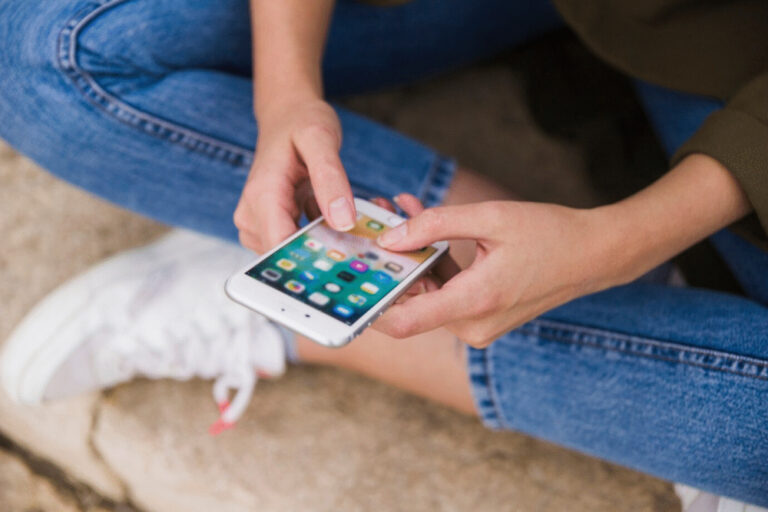
Is the constant scroll leaving you feeling empty rather than fulfilled? Do you find yourself reaching for your phone the moment you wake up, before you’ve even said good morning to yourself or loved ones? If the glow of your screen has become your most consistent companion, you’re not alone. In today’s hyperconnected world, our screens are essential for both work and social life, but they are also a leading cause of distraction and burnout. This guide is your starting point for proactively Managing Screen Time a crucial skill for modern well-being.
Americans check their phones an average of 352 times daily—that’s once every 4 minutes of waking life. Even more alarming, research from the Global Web Index shows the average person now spends over 2 hours and 27 minutes on social media platforms every single day. That’s more than 5 years of an average lifetime spent scrolling through feeds.
As a digital wellness consultant who’s helped hundreds of individuals and organizations establish healthier tech boundaries, I’ve witnessed firsthand how social media’s carefully engineered engagement mechanisms have transformed our relationship with technology from useful tool to compulsive habit.
In this comprehensive guide, you’ll discover:
- The psychological hooks that make social media so addictive
- Clear signs your relationship with social media has become unhealthy
- A day-by-day blueprint for a 30-day social media detox
- Practical strategies to reintegrate social platforms mindfully
- Tools to maintain lasting digital balance after your detox
By the end of this post, you’ll have everything you need to break free from the endless scroll and rediscover life beyond the screen. This isn’t about demonizing technology, but about putting you back in control of when, how, and why you engage with it.

Understanding the Social Media Dependency Cycle
Our brains were never designed to resist the sophisticated engagement mechanisms of modern social platforms.
This isn’t merely a matter of weak willpower or poor self-discipline. The dependency cycle is rooted in fundamental brain chemistry and psychology that social media companies have learned to exploit with remarkable precision.
Every notification, like, and comment triggers a small dopamine release in your brain—the same neurotransmitter involved in all reward-seeking behaviors. These platforms have essentially created the perfect dopamine delivery system, offering unpredictable rewards (Will someone like my post? What’s in my feed now?) that keep us coming back with the consistency of lab rats pressing a lever.
Dr. Anna Lembke, Chief of Addiction Medicine at Stanford University School of Medicine, explains: “Social media platforms are essentially digital casinos. The intermittent reinforcement schedule—sometimes you get likes, sometimes you don’t—is exactly what makes gambling so addictive.”
Beyond dopamine, these platforms serve legitimate psychological needs:
- Connection (albeit often superficial)
- Validation and social affirmation
- Information gathering and curiosity fulfillment
- Identity expression and exploration
- Escapism from daily stressors
Why is this particularly problematic now? Today’s social media combines unprecedented psychological research, sophisticated AI algorithms, and the convenience of 24/7 access in your pocket. This perfect storm has created engagement tools far more advanced than our evolutionary defenses against distraction.
By understanding these mechanisms, you can approach your detox not as a test of willpower, but as a recalibration of systems that were designed to capture your attention in the first place.
10 Warning Signs Your Social Media Use Has Become Problematic
How do you know when casual scrolling has crossed into dependency? Look for these clear indicators:
• The first and last check: Your day begins and ends with social media, often before getting out of bed and right before sleep. Your screen time is bookending your day, displacing reflection and rest.
• Phantom vibrations: You frequently feel your phone vibrate when it hasn’t, or check it without notifications. Your nervous system has been conditioned to anticipate social media engagement.
• Comparison distress: You regularly feel inadequate, jealous, or anxious after viewing others’ posts. Social media presents highly curated realities that inevitably distort your perception.
• Time blindness: You lose track of time while scrolling, often spending much longer than intended. The endless scroll feature was specifically designed to eliminate natural stopping cues.
• Withdrawal symptoms: You feel anxious, irritable, or restless when unable to check social media. This mirrors the withdrawal patterns seen in other behavioral addictions.
• Social displacement: In-person interactions are frequently interrupted by checking platforms. Digital connections are displacing deeper face-to-face relationships.
• Failed reduction attempts: Previous efforts to cut back have been unsuccessful. This indicates the habit has become compulsive rather than conscious.
• Mood-dependent usage: You turn to social media when feeling bored, lonely, or uncomfortable. The platforms have become your emotional regulation strategy.
• Sleep disruption: Your sleep quality or duration has diminished due to late-night scrolling. Both the blue light and mental stimulation interfere with healthy sleep cycles.
• Productivity impact: Work, studies, or personal projects regularly suffer from social media distractions. Your most valuable asset—focused attention—is being fractured by constant checking.
How many of these signs do you recognize in your own life? Even identifying with 2-3 suggests it’s time to reassess your relationship with social media.
Preparation: Setting Your Detox Up for Success
Proper preparation is not just helpful for your social media detox—it’s absolutely essential.
Without thoughtful preparation, most detox attempts fail within days. Research from the University of Bath found that participants who spent just 15 minutes planning their digital detox were three times more likely to complete it than those who jumped in unprepared.
Why does preparation matter so much? Because social media platforms have become deeply integrated into our daily routines, social connections, and even how we validate our experiences. Removing them without preparation creates a vacuum that’s uncomfortable to sit with.
Evidence shows that successful behavioral change requires environmental restructuring, clear intention setting, and anticipation of obstacles—all elements of proper preparation.
To set yourself up for success, follow these critical preparation steps:
1. Define Your “Why”
Write down specific, personal reasons for undertaking this detox:
- What relationships do you hope to improve?
- What activities do you want more time for?
- What mental or emotional benefits are you seeking?
Keep this list somewhere visible during your detox for motivation during challenging moments.
2. Establish Clear Rules and Boundaries
Decide exactly what your detox will entail:
- Complete elimination of all social platforms or just certain ones?
- Will you delete apps or just log out?
- Are there specific exceptions (e.g., Facebook events for work purposes)?
- How will you handle social media embedded in other apps (like news sites)?
Ambiguity leads to rationalization, so be specific.
3. Create Accountability
- Announce your detox to at least three supportive people
- Consider finding a detox partner to undertake the challenge with you
- Use a habit tracking app (ironically, technology to help manage technology)
- Schedule weekly check-ins with yourself to assess progress
4. Prepare Your Environment
- Delete social media apps from your phone
- Log out of all accounts on browsers
- Install website blockers on computers (like Freedom or Cold Turkey)
- Rearrange your home screen to remove visual triggers
- Create a “parking spot” for your phone outside your bedroom
5. Plan Replacement Activities
Nature abhors a vacuum, and so does human behavior. Plan specific alternatives:
- Place a book in spots where you typically scroll
- Download podcasts for commute times
- Prepare a list of friends to call when feeling socially disconnected
- Identify three new skills you’ve wanted to develop
By taking these preparation steps seriously, you transform your detox from a test of willpower into a thoughtfully designed lifestyle experiment with significantly higher chances of success.
Start your preparation phase at least three days before your official detox begins to allow time for proper setup and mental adjustment.
The 30-Day Social Media Detox Blueprint
A structured, progressive approach to digital detoxing creates sustainable change rather than temporary relief.
Research from the University College London suggests that while old habits never completely disappear, new neural pathways can be formed in as little as 30 days of consistent practice. This blueprint leverages that science to help you break social media dependency in distinct phases.
Week 1: The Digital Cleanse (Days 1-7)
Objective: Complete disconnect to break the automatic usage cycle
Daily Actions:
- Morning: Replace your usual “wake and check” routine with 5 minutes of deep breathing or stretching
- Throughout day: Notice and log trigger moments when you crave social media
- Evening: Write a short reflection on observations, challenges, and positive changes noticed
What to Expect:
- Days 1-3: Initial withdrawal symptoms including restlessness, FOMO, and habitual reaching for your phone
- Days 4-7: Gradually increasing mental clarity and attention span
Success Tips:
- Keep your phone in a different room while working
- Disable ALL notifications, not just social media
- Share one genuine observation with a friend each day via text or call
Celebrate: At week’s end, treat yourself to something meaningful that isn’t technology-related
Week 2: Reconnection & Discovery (Days 8-14)
Objective: Fill the void with meaningful activities and connections
Daily Actions:
- Implement one new morning routine activity (journaling, reading, meditation)
- Engage in at least 15 minutes of an offline hobby
- Have one face-to-face or voice conversation with someone important to you
What to Expect:
- Increased awareness of how much time you actually have
- Moments of boredom as your brain adjusts to less stimulation
- Potential anxiety about “missing out” on social news
Success Tips:
- Keep a “curiosity list” of things you want to look up later (rather than immediately)
- Take photos for yourself, not for sharing
- Notice environment details you previously missed while looking at your phone
Celebrate: Plan a small gathering or outing that involves genuine connection
Week 3: Identity Recalibration (Days 15-21)
Objective: Separate your sense of self from your social media presence
Daily Actions:
- Journal about aspects of yourself that aren’t reflected in your social profiles
- Practice one act of private achievement (something worthwhile with no documentation)
- Engage with news/information through intentional, time-limited sources
What to Expect:
- Questioning of certain relationships or interests
- A shift in how you measure personal value
- Potential identity discomfort as you separate from online persona
Success Tips:
- Review old photos or mementos that remind you of pre-social media joys
- Ask trusted friends what they value most about you (likely not your posts)
- Notice how your attention span has changed since beginning the detox
Celebrate: Create something physical that represents your offline identity
Week 4: Mindful Reintegration Planning (Days 22-30)
Objective: Develop a sustainable approach to social media moving forward
Daily Actions:
- Draft specific guidelines for your post-detox social media use
- Experiment with time-limited, purpose-driven technology use in other areas
- Reflect on which aspects of the detox you want to maintain permanently
What to Expect:
- Clearer perspective on social media’s actual value in your life
- Reduced urgency around checking platforms
- Potential anxiety about returning to old habits
Success Tips:
- Create a social media usage plan with specific time blocks
- Decide which accounts or connections truly enrich your life
- Set up physical and digital boundaries for your reintegration
Celebrate: On day 30, write a letter to yourself about what you’ve learned and how you want to move forward
“The first time you disconnect can feel like holding your breath underwater. With practice, you develop the capacity to stay present in the offline world with ease and grace.” — Dr. Cal Newport, Digital Minimalism author
Mindful Reintegration: Creating a Healthier Relationship Moving Forward
Completely eliminating social media isn’t realistic or necessary for most people—the key is transforming from passive consumer to intentional user.
After 30 days away from social platforms, you have a rare opportunity to redefine your relationship with these tools on your own terms. Research from the Digital Wellness Institute shows that people who reintegrate social media with clear boundaries report 64% higher satisfaction with their technology use than those who return to unrestricted habits.
Your brain has now experienced a reset of its reward pathways, creating space for more conscious choices. Here’s how to maintain your digital wellbeing:
Time Boundaries
- Designate specific times for social media use (e.g., 15 minutes at lunch, 20 minutes after dinner)
- Use timer features or apps like Flora that lock you out once your allotted time expires
- Implement a “social media sabbath”—one day weekly with no platform access
Content Boundaries
- Ruthlessly curate your feeds to include only truly valuable connections
- Unfollow accounts that trigger comparison or negative emotions
- Use lists or groups to categorize contacts, allowing for more directed attention
Physical Boundaries
- Establish tech-free zones in your home (bedroom, dining area, bathroom)
- Create tech-free times (first hour after waking, during meals, last hour before bed)
- Store devices out of sight when not in active use to prevent unconscious checking
Purpose-Driven Usage
- Before opening any app, explicitly name your purpose (e.g., “I’m checking Instagram to see my cousin’s new baby photos, then logging off”)
- Disable the infinite scroll feature when possible by using browser extensions
- Switch from passive consumption to active creation when on platforms
Ongoing Awareness Practices
- Weekly audit your screen time reports
- Monthly reassess which platforms truly add value
- Quarterly “mini-detoxes” of 24-72 hours to maintain perspective
Remember that social media companies regularly update their engagement features to recapture your attention. What works as a boundary today may need adjustment tomorrow. The key is maintaining conscious awareness rather than slipping back into automatic patterns.
Treat this reintegration as an experiment: try different boundaries, observe the results, and refine your approach based on what creates the most balanced relationship with technology for your specific life.
Troubleshooting Common Detox Challenges
Even with the best preparation, obstacles will arise during your detox journey. Having specific solutions ready will help you navigate these predictable challenges.
Challenge #1: Intense FOMO (Fear of Missing Out)
When you’re suddenly disconnected from social feeds, anxiety about missing important news or events can be overwhelming.
Solution:
- Ask 2-3 close friends to text you directly about truly important news or events
- Schedule weekly “update calls” with socially connected friends
- Remind yourself that genuinely important information will reach you through other channels
- Use a journal to explore what specific things you fear missing and whether they truly impact your life
Challenge #2: Social Pressure to Return
Friends, family, or colleagues may inadvertently undermine your detox with comments like “Did you see what I posted?” or “Why haven’t you responded to my tag?”
Solution:
- Prepare a brief, positive explanation of your detox in advance
- Request specific alternate contact methods from important connections
- Suggest alternate activities when friends default to scrolling during shared time
- Remember that your boundaries often inspire others to examine their own habits
Challenge #3: Professional Concerns
Many jobs now involve social media or have shifted important communications to these platforms.
Solution:
- Notify professional contacts of your temporary absence and provide alternatives
- Consider a designated check time solely for professional accounts (distinct from personal usage)
- Delegate social responsibilities temporarily if possible
- Use vacation responders or status updates to manage expectations
Challenge #4: The Void and Boredom
After years of filling every idle moment with scrolling, genuine boredom can feel uncomfortable or even anxiety-producing.
Solution:
- Recognize boredom as the birthplace of creativity and depth
- Keep a “boredom emergency kit” with analog activities you enjoy
- Practice sitting with discomfort rather than immediately escaping it
- Start a curiosity journal to capture questions you’d normally satisfy with immediate searches
Challenge #5: Relapse
If you break your detox rules, shame and an “all-or-nothing” mindset can derail your entire effort.
Solution:
- Implement the “next meal” approach—if you overeat at lunch, you don’t skip dinner; you simply return to healthy eating
- Document the trigger, context, and feeling that preceded the relapse
- Adjust your environment or rules based on this insight
- Reset without self-judgment, perhaps with a “recommitment ritual”
When to Seek Professional Support
If your detox attempts reveal more significant patterns, consider professional guidance:
- Persistent feelings of anxiety or depression when not using social media
- Usage that continues despite serious negative consequences to relationships or work
- Inability to control usage despite multiple structured attempts
- Using social media to escape difficult emotions or trauma
Digital wellness coaches, therapists specializing in behavioral addictions, or support groups can provide additional structure and accountability.
“Setbacks aren’t failures—they’re data points that help you refine your approach to lasting change.” — Dr. BJ Fogg, Behavior Design expert
Reclaiming Your Digital Autonomy: The Path Forward
The most important outcome of your 30-day detox isn’t temporary abstinence—it’s permanent transformation in how you engage with technology.
Throughout this challenge, you’ve done more than just take a break from scrolling—you’ve recalibrated your attention, reconnected with offline values, and rediscovered your capacity for deep focus and genuine connection. Research from the Journal of Social Psychology indicates that people who complete structured digital detoxes report a 31% increase in life satisfaction and a 27% decrease in anxiety three months after their detox period.
What you’ve really gained is digital autonomy—the ability to make conscious choices about when, why, and how you engage with social media rather than responding to its carefully engineered demands for your attention.
As you move forward:
- Trust your new awareness. You now recognize how platforms are designed to capture and hold your attention, making you a more discerning digital citizen.
- Value your attention as currency. Every minute spent scrolling is a minute not spent on relationships, creativity, rest, or growth. Budget it as carefully as you would your finances.
- Embrace digital minimalism. Question whether each platform, follow, and notification truly adds value proportional to its cost in time and mental energy.
- Maintain regular recalibration. Consider implementing quarterly mini-detoxes (24-72 hours) to maintain your perspective and prevent unconscious slide back into old patterns.
The ultimate goal isn’t perfection or total elimination, but a relationship with technology that enhances rather than diminishes your experience of what matters most in your life.
Ready to take the next step? Download our free Social Media Reintegration Planner to create a customized framework for maintaining your digital wellness beyond the 30-day mark. This printable resource includes:
- A template for creating personal usage guidelines
- Weekly check-in prompts to maintain awareness
- Strategies for handling new platform features designed to increase engagement
- A troubleshooting guide for common reintegration challenges
Your journey toward digital wellness isn’t ending—it’s just beginning. The insights and habits you’ve developed during these 30 days provide the foundation for a lifetime of intentional engagement with the digital world.
Frequently Asked Questions
Will I miss important information during my detox?
Truly important information has multiple paths to reach you. For specific concerns, designate a “information buddy” who can alert you to anything urgent, or schedule specific, time-limited check-ins for critical platforms (like community groups). Remember that most of what feels urgent on social media rarely impacts your real life significantly.
What if my job requires social media use?
Consider a modified detox that separates professional and personal use. Create a distinct work profile, use it only during designated work hours, and access it from a specific device or browser. This maintains the psychological benefits of the detox while acknowledging professional requirements. Alternatively, explore whether tasks can be delegated or batched into limited time periods during your detox.
Won’t I just go back to old habits after 30 days?
Research shows that 30 days is sufficient to weaken neural pathways of habit and establish new ones, but only if accompanied by conscious reintegration. The fourth week of the blueprint specifically prepares you for sustainable change rather than temporary abstinence. Those who create clear, specific plans for post-detox usage maintain approximately 70% of the benefits gained during their detox period.
Is it really necessary to delete the apps, or can I just promise not to use them?
Relying solely on willpower dramatically reduces success rates. Environmental restructuring—physically removing access—is consistently shown to be more effective than intention alone. Think of it this way: if you were trying to eat healthier, would keeping cookies on your nightstand be a good strategy? App deletion creates helpful friction between impulse and action.
What about positive aspects of social media like staying connected with distant friends or support groups?
The detox period helps you distinguish between genuinely enriching connections and low-value scrolling. After 30 days, you’ll have clearer discernment about which specific connections add real value. Consider extracting high-value connections to alternative communication methods (direct messaging, email newsletters, private groups) that don’t require wading through algorithmic feeds.
What if I experience withdrawal symptoms like anxiety or irritability?
These symptoms are normal and typically peak around days 2-4 before gradually subsiding. They actually confirm your detox is necessary, as they indicate dependency. Practice self-compassion, use the replacement activities you planned, and remember that discomfort is part of any meaningful change process. If symptoms are severe or persist beyond a week, consider consulting a mental health professional.






